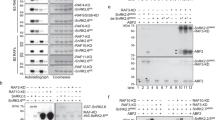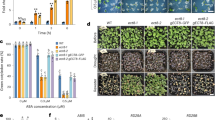Abstract
Abscisic acid (ABA) is a ubiquitous hormone that regulates plant growth, development and responses to environmental stresses. Its action is mediated by the PYR/PYL/RCAR family of START proteins, but it remains unclear how these receptors bind ABA and, in turn, how hormone binding leads to inhibition of the downstream type 2C protein phosphatase (PP2C) effectors. Here we report crystal structures of apo and ABA-bound receptors as well as a ternary PYL2–ABA–PP2C complex. The apo receptors contain an open ligand-binding pocket flanked by a gate that closes in response to ABA by way of conformational changes in two highly conserved β-loops that serve as a gate and latch. Moreover, ABA-induced closure of the gate creates a surface that enables the receptor to dock into and competitively inhibit the PP2C active site. A conserved tryptophan in the PP2C inserts directly between the gate and latch, which functions to further lock the receptor in a closed conformation. Together, our results identify a conserved gate–latch–lock mechanism underlying ABA signalling.
This is a preview of subscription content, access via your institution
Access options
Subscribe to this journal
Receive 51 print issues and online access
$199.00 per year
only $3.90 per issue
Buy this article
- Purchase on Springer Link
- Instant access to full article PDF
Prices may be subject to local taxes which are calculated during checkout






Similar content being viewed by others
Accession codes
Primary accessions
Protein Data Bank
Data deposits
The structure factors and atomic coordinates discussed in this work have been deposited in the Protein Data Bank. The accession codes are: 3KAY for apo-PYL1; 3KAZ for apo-PYL2; 3KB0 for the ABA-bound PYL2 complex; and 3KB3 for the ternary complex of PYL2–ABA–HAB1.
References
Yoshida, T. et al. ABA-hypersensitive germination3 encodes a protein phosphatase 2C (AtPP2CA) that strongly regulates abscisic acid signaling during germination among Arabidopsis protein phosphatase 2Cs. Plant Physiol. 140, 115–126 (2006)
Mustilli, A. C., Merlot, S., Vavasseur, A., Fenzi, F. & Giraudat, J. Arabidopsis OST1 protein kinase mediates the regulation of stomatal aperture by abscisic acid and acts upstream of reactive oxygen species production. Plant Cell 14, 3089–3099 (2002)
Chinnusamy, V., Gong, Z. & Zhu, J. K. Abscisic acid-mediated epigenetic processes in plant development and stress responses. J. Integr. Plant Biol. 50, 1187–1195 (2008)
Yoshida, R. et al. ABA-activated SnRK2 protein kinase is required for dehydration stress signaling in Arabidopsis . Plant Cell Physiol. 43, 1473–1483 (2002)
Fujii, H., Verslues, P. E. & Zhu, J. K. Identification of two protein kinases required for abscisic acid regulation of seed germination, root growth, and gene expression in Arabidopsis . Plant Cell 19, 485–494 (2007)
Pennisi, E. Plant biology. Stressed out over a stress hormone. Science 324, 1012–1013 (2009)
Park, S. Y. et al. Abscisic acid inhibits type 2C protein phosphatases via the PYR/PYL family of START proteins. Science 324, 1068–1071 (2009)
Ma, Y. et al. Regulators of PP2C phosphatase activity function as abscisic acid sensors. Science 324, 1064–1068 (2009)
Santiago, J. et al. Modulation of drought resistance by the abscisic acid receptor PYL5 through inhibition of clade A PP2Cs. Plant J. 10.1111/j.1365-313X.2009.03981.x (published online 16 July 2009)
Kobayashi, Y. et al. Abscisic acid-activated SNRK2 protein kinases function in the gene-regulation pathway of ABA signal transduction by phosphorylating ABA response element-binding factors. Plant J. 44, 939–949 (2005)
Furihata, T. et al. Abscisic acid-dependent multisite phosphorylation regulates the activity of a transcription activator AREB1. Proc. Natl Acad. Sci. USA 103, 1988–1993 (2006)
Zhu, J. K. Salt and drought stress signal transduction in plants. Annu. Rev. Plant Biol. 53, 247–273 (2002)
Yamaguchi-Shinozaki, K. & Shinozaki, K. Transcriptional regulatory networks in cellular responses and tolerance to dehydration and cold stresses. Annu. Rev. Plant Biol. 57, 781–803 (2006)
Gajhede, M. et al. X-ray and NMR structure of Bet v 1, the origin of birch pollen allergy. Nature Struct. Biol. 3, 1040–1045 (1996)
Iyer, L. M., Koonin, E. V. & Aravind, L. Adaptations of the helix-grip fold for ligand binding and catalysis in the START domain superfamily. Proteins 43, 134–144 (2001)
Almo, S. C. et al. Structural genomics of protein phosphatases. J. Struct. Funct. Genomics 8, 121–140 (2007)
Das, A. K., Helps, N. R., Cohen, P. T. & Barford, D. Crystal structure of the protein serine/threonine phosphatase 2C at 2.0 Å resolution. EMBO J. 15, 6798–6809 (1996)
Bertauche, N., Leung, J. & Giraudat, J. Protein phosphatase activity of abscisic acid insensitive 1 (ABI1) protein from Arabidopsis thaliana . Eur. J. Biochem. 241, 193–200 (1996)
Sheen, J. Mutational analysis of protein phosphatase 2C involved in abscisic acid signal transduction in higher plants. Proc. Natl Acad. Sci. USA 95, 975–980 (1998)
Yoo, S. D., Cho, Y. H. & Sheen, J. Arabidopsis mesophyll protoplasts: a versatile cell system for transient gene expression analysis. Nature Protocols 2, 1565–1572 (2007)
Allen-Baume, V., Segui, B. & Cockcroft, S. Current thoughts on the phosphatidylinositol transfer protein family. FEBS Lett. 531, 74–80 (2002)
Seedorf, U., Ellinghaus, P. & Roch Nofer, J. Sterol carrier protein-2. Biochim. Biophys. Acta 1486, 45–54 (2000)
Wirtz, K. W. Phospholipid transfer proteins in perspective. FEBS Lett. 580, 5436–5441 (2006)
Schrick, K., Nguyen, D., Karlowski, W. M. & Mayer, K. F. START lipid/sterol-binding domains are amplified in plants and are predominantly associated with homeodomain transcription factors. Genome Biol. 5, R41 (2004)
Olayioye, M. A. et al. StarD10, a START domain protein overexpressed in breast cancer, functions as a phospholipid transfer protein. J. Biol. Chem. 280, 27436–27442 (2005)
McCoy, A. J. et al. Phaser crystallographic software. J. Appl. Crystallogr. 40, 658–674 (2007)
Emsley, P. & Cowtan, K. Coot: model-building tools for molecular graphics. Acta Crystallogr. D 60, 2126–2132 (2004)
Kleywegt, G. J. & Jones, T. A. Efficient rebuilding of protein structures. Acta Crystallogr. D 52, 829–832 (1996)
Brunger, A. T. et al. Crystallography & NMR system: a new software suite for macromolecular structure determination. Acta Crystallogr. D 54, 905–921 (1998)
Murshudov, G. N., Vagin, A. A., Lebedev, A., Wilson, K. S. & Dodson, E. J. Efficient anisotropic refinement of macromolecular structures using FFT. Acta Crystallogr. D 55, 247–255 (1999)
Smith, P. A. et al. A plasmid expression system for quantitative in vivo biotinylation of thioredoxin fusion proteins in Escherichia coli . Nucleic Acids Res. 26, 1414–1420 (1998)
Otwinowski, Z., Borek, D., Majewski, W. & Minor, W. Multiparametric scaling of diffraction intensities. Acta Crystallogr. A 59, 228–234 (2003)
Kleywegt, G. J. & Jones, T. A. Detection, delineation, measurement and display of cavities in macromolecular structures. Acta Crystallogr. D 50, 178–185 (1994)
Wiehe, K. et al. The performance of ZDOCK and ZRANK in rounds 6–11 of CAPRI. Proteins 69, 719–725 (2007)
Li, Y., Kovach, A., Suino-Powell, K., Martynowski, D. & Xu, H. E. Structural and biochemical basis for the binding selectivity of peroxisome proliferator-activated receptor gamma to PGC-1alpha. J. Biol. Chem. 283, 19132–19139 (2008)
Suino, K. et al. The nuclear xenobiotic receptor CAR; structural determinants of constitutive activation and heterodimerization. Mol. Cell 16, 893–905 (2004)
Xu, H. E. et al. Structural basis for antagonist-mediated recruitment of nuclear co-repressors by PPARalpha. Nature 415, 813–817 (2002)
Cutler, S. R., Ehrhardt, D. W., Griffitts, J. S. & Somerville, C. R. Random GFP:cDNA fusions enable visualization of subcellular structures in cells of Arabidopsis at a high frequency. Proc. Natl Acad. Sci. USA 97, 3718–3723 (2000)
Delaglio, F. et al. NMRPipe: a multidimensional spectral processing system based on UNIX pipes. J. Biomol. NMR 6, 277–293 (1995)
Bartels, C., Günterts, P., Billeter, M. & Wüthrich, K. GARANT — a general algorithm for resonance assignment of multidimensional nuclear magnetic resonance spectra. J. Comput. Chem. 18, 139–149 (1997)
Bahrami, A., Assadi, A. H., Markley, J. L. & Eghbalnia, H. R. Probabilistic interaction network of evidence algorithm and its application to complete labeling of peak lists from protein NMR spectroscopy. PLOS Comput. Biol. 5, e1000307 (2009)
Acknowledgements
We thank the staff of LS-CAT for assistance in data collection at the beam lines of sector 21, which is in part funded by the Michigan Economic Development Corporation and the Michigan Technology Tri-Corridor. Use of the Advanced Photon Source was supported by the Office of Science of the US Department of Energy. This work was supported by the Jay and Betty Van Andel Foundation (H.E.X.), the National Institutes of Health (H.E.X., B.F.V. and J-K. Z.), and the National Science Foundation (S.R.C.). L.-M.N. and F.-F.S. were supported by an overseas PhD scholarship from the NUS Graduate School for Integrative Sciences & Engineering (NGS).
Author Contributions K.M., Jun Li, Jiayang Li, E.-L.Y., B.F.V., S.R.C., J.-K.Z. and H.E.X. conceived the project and designed research; K.M., L.-M.N., X.E.Z., F.-F.S., Y.X., K.M.S.-P., S.-Y.P., J.J.W., H.F., V.C., A.K., Y.W., F.C.P., D.R.J. and H.E.X. performed research; K.M., L.-M.N., X.E.Z., F.-F.S., Y.X., K.M.S.-P., S.-Y.P., J.J.W., H.F., V.C., B.F.V., S.R.C., J.-K.Z. and H.E.X. analysed data; and K.M., S.R.C. and H.E.X. wrote the paper with contributions from all authors.
Author information
Authors and Affiliations
Corresponding author
Supplementary information
Supplementary Information
This file contains Supplementary Tables 1-3 and Supplementary Figures 1-6 with Legends. (PDF 1761 kb)
Rights and permissions
About this article
Cite this article
Melcher, K., Ng, LM., Zhou, X. et al. A gate–latch–lock mechanism for hormone signalling by abscisic acid receptors . Nature 462, 602–608 (2009). https://doi.org/10.1038/nature08613
Received:
Accepted:
Published:
Issue Date:
DOI: https://doi.org/10.1038/nature08613
This article is cited by
-
An orthogonalized PYR1-based CID module with reprogrammable ligand-binding specificity
Nature Chemical Biology (2024)
-
Meta-analysis of microarray and RNAseq data reveal OsbZIP52 to mediate salt stress responses in sensitive, tolerant and halophyte rice varieties
CABI Agriculture and Bioscience (2023)
-
The CBL1/9-CIPK1 calcium sensor negatively regulates drought stress by phosphorylating the PYLs ABA receptor
Nature Communications (2023)
-
Melatonin Promotes Seed Germination via Regulation of ABA Signaling Under Low Temperature Stress in Cucumber
Journal of Plant Growth Regulation (2023)
-
APETALA2 is involved in ABA signaling during seed germination
Plant Molecular Biology (2023)
Comments
By submitting a comment you agree to abide by our Terms and Community Guidelines. If you find something abusive or that does not comply with our terms or guidelines please flag it as inappropriate.



